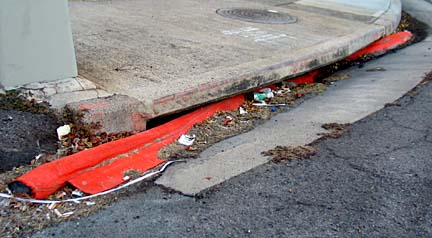
Making your marker
MANY cities have markers denoting historic or cultural sites. Some folks are even so proud of their historic (or tax-writeoff) homes, they hang plaques outside. The question is consistency -- will passersby recognize an "official" marker as such? Is the information accurate and helpful, and who's responsible for making it so? What if the building owner changes, and the attitude toward such a marker as well? It's useful to remember that the sidewalks are the property of the city and county, and some municipalities place their markers in the sidewalk so they can control the content and legibility of the markers.
Despite efforts in Waikiki, Honolulu has no coherent historic marker system. Our skull-bending question this month deals with what such a system might look like and the subjects it might cover.
Artist-actor-author-chef-brainiac John Leonard Werrill's concept is "a Plexiglas, light-transparent, weather-resistant, oblong thermoplastic assembly, secured to a white conch shell approximately 3 to 4 feet wide. Gold lettering attached to the Plexiglas about 1 foot in depth and 3.5 feet long. Conch shell attached to wall of building or assembled separately in a visible spot, on a brick and koa base. Poly- urethane-coated thermoplastic wave formation on front lip of shell. Plastic yellow hibiscus (state flower) on left, attached. Three strong spotlights arranged evenly on the inside lip, center, right and left. Subject shown, lit for effective night vision display. Could be left on during the day, but not essential. Letters in fluorescent gold for further visibility and effect."
Yep, you'd be able to see Werrill's creation from a long way off. Another artist who's put a lot of thought into this is Bill Braden of Haleiwa, who brings our attention to a "Trailmarker Project," which he calls "a community-based project that includes(as part of its goals) permanent markers signifying historic or cultural sites and locations. The form of the edifices is a variation of one of the indigenous Trailmarkers, piles of native stones built by the ancient Hawaiians to mark trails and in some case to mark significant sites. In our current version, we are planning on using 1/2- to 5-ton local boulders to discourage vandalism and theft. The beauty of using boulders from the area is that this eons-old material will speak of the area's geologic heritage, and also the mana of the stones will emit its own message, a phenomenon recognized here in these islands. Perhaps the most important feature of the Trailmarker project is the deeply etched designs (not to be called petroglyphs by order of the kupuna, so as to avoid confusing them with the ancients' petroglyphs) to be carved onto the boulders. These designs have been and more will be submitted by the schoolchildren of each area, and the kupuna will choose which ones will be actualized.
"As part of the North Shore Vision Team projects, two 30-foot-high Trailmarkers have been designated as "gateway features" at either end of the Joseph P. Leong Highway (Haleiwa bypass road). These will feature many designs on the 20-foot stacked boulders that will be on top of a 10-foot pedestal clad with moss-rock. At the specific individual locations of cultural and historic significance will be smaller, snowman-size Trailmarkers," Braden summarized. He enclosed a sketch that was submitted to the city's "21st- Century Oahu" plan.
"I thought we already have colorful and unique Hawaiian warrior signs on poles at all major visitor spots. Why change a good thing?" wondered Alvin Wong of Pearl City.
"All over Japan and some other countries, the manhole covers in the streets and sidewalks are cast with specific designs (many in color) identifying the area, community or city," Walter Ozawa of Honolulu wrote. "The conversion process can be gradual and can include the utilities, water, sewer, electric and telephone companies. Replacing them as streets are reconstructed, for example, or for specific areas such as the historic civic center, Capitol district, Chinatown, etc.
"Also, if a private historic structure is identified, a bronze or ceramic plaque ought to be available for purchase, with proper authentication, and made widely available and affordable," he suggested.
"A nice marker to signify Hawaii's landmark in the area would be to paint a red hibiscus or yellow plumeria flower or lei on the sidewalk," said Michael Nomura of Kailua.
And then there was the reader who wanted markers set up all over the island to warn tourists about ... well, about everything! I guess that's a bit of local history as well.
BACK TO TOP |
Next month's Brainstorm!
BURL BURLINGAME / BBURLINGAME@STARBULLETIN.COM
Next Brainstorm: Can you create a better design for these hideous storm-drain filters?
Dirty gutter talk
Those orange rolls that highway engineers have been shoving into storm drain openings -- there must be a more efficient or practical or attractive way to filter out road debris. These things are about as useful and pleasing to the eye as huge, discarded cigarette butts. Send your ideas and solutions by Dec. 17 to:
Or mail them to:
Brainstorm!
c/o Burl Burlingame
Star-Bulletin
500 Ala Moana
7 Waterfront Plaza, Suite 210
Honolulu, Hawaii 96813Fax:
Brainstorm!
c/o Burl Burlingame
529-4750
